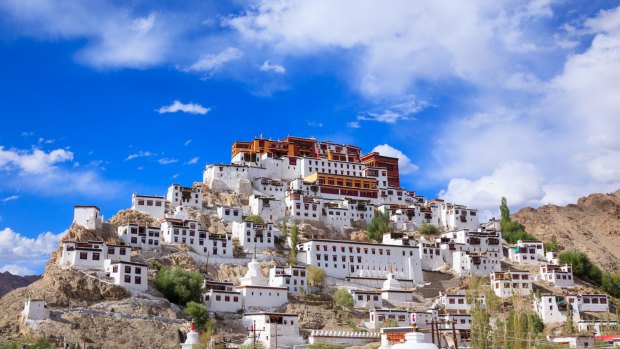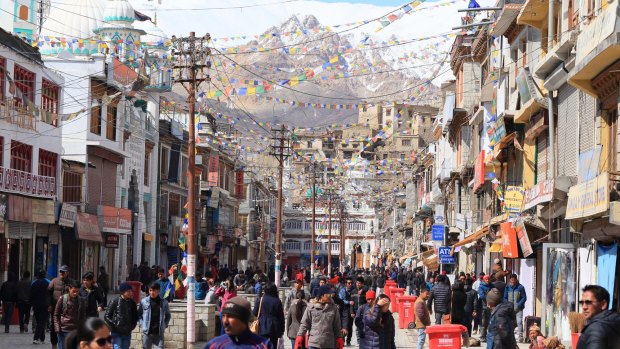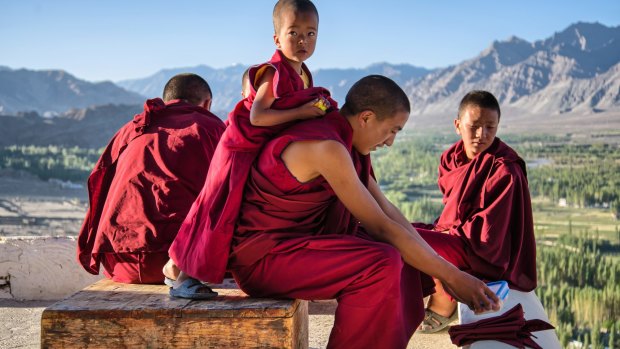This was published 6 years ago
Private, luxury tours in Ladakh, India: The ultimate destination to rediscover yourself

Thiksey Gompa, Leh Ladakh.Credit: Shutterstock
"Wondering where we're going?" asks guide Pujan Rai, teasing from the backseat. Our vehicle is twisting its way into a lush cleft between Ladakh's stark peaks, which soar above the treeline. After passing Likir monastery's giant golden Buddha, we're zigzagging higher on a track running between ingenious stone-wall channels that guide meltwater into fields sprouting barley, wheat and mustard greens during the brief summer growing season.
"Our drivers always say that where the road ends, that's where you'll find a Shakti house," Rai explains as we pull up outside a home that indeed seems to sit at the end of the earth. I spin around to gaze upon the reason this address was chosen above all others in Likir: dominating the view is the formidable Zanskar Range still draped in snow – one of the stupendous sights that have attracted visitors since 1974 when foreigners were first allowed into this strategically sensitive part of northern India.
Welcome to another extraordinary day with Shakti Himalaya, a company that offers luxury private touring in three remote parts of the Indian Himalayas: Kumaon in Uttarakhand north-east of Delhi, Sikkim wedged between Nepal and Bhutan to the east, and Ladakh, part of the state of Jammu and Kashmir. Ladakh is a high-altitude desert bordering Pakistan and China yet it's hardly monochrome. Pops of colour come from wild irises framing ploughed fields and leaves sprouting from ramrod-straight poplars. Prayer flags flutter from bridges and rooftops, monks go about their business enveloped in crimson and soldiers sport speckled camouflage. Roads leading to the Ladakhi capital of Leh are lined with neat-as-a-pin bases for a rollcall of Army corps – Tuskers, Fire and Fury, and more – along with amusing safety signs from the Border Roads Organisation (the poetic "After whisky driving risky" is my favourite).

The streets of Leh, Ladakh.Credit: Shutterstock
In Ladakh, Shakti guests swing around between a portfolio of village homes, never sharing with other guests that aren't part of their entourage but occasionally crossing paths with homeowners who have moved next door or into separate quarters for the season. Their homes' traditional exteriors have been maintained but interiors have been put through a hip makeover. Designer Ellie Stanton, who hails from Stratford upon Avon but now lives in Kolkata, tastefully translates the local vernacular while incorporating motifs of Buddhism so central to life in Ladakh that the region is known as Little Tibet.
Some design choices – such as a framed print of a conch shell – can seem puzzling but then you learn it's one of Buddhism's eight auspicious symbols and it all makes sense. Other things about Stanton's creative process emerge as the week rolls on. Shakti's Likir Village House (the one with the in-your-face mountain views) belongs to a herder-cum-carpenter who weaves willow branches into gates. Stanton amplifies the notion, installing woven willow panels as an entire bathroom wall in a room at a house overlooking the roaring Indus River. Even the tiniest objet d'art leads to new discoveries. A miniature woollen snow leopard on a library shelf, for instance, leads me to Leh's Snow Leopard Conservancy, which sells the handicrafts for village women trying to recoup the cost of livestock killed by snow leopards and other predators.
After initial reticence, Ladakhi families now approach Shakti to offer their homes for one of these stunning transformations. I'm told one makeover even had locals flocking to see the en-suite bathrooms. This makes me curious about usual bathroom set-ups. Thanks to too much breakfast coffee and a torturous drive from Nimu to meet 78-year-old metalsmith Richen Palden at Chilling (it takes an hour to travel 25 kilometres along what seems one of the world's most treacherous roads), I'm in urgent need of a family's facility – two holes in a dirt floor out the back.

Spiritual abundance: Young Buddhist monks in Thiksey, Ladakh.Credit: Shutterstock
Homestays have become part of Ladakh's tourism landscape, which means adventurous travellers can embrace this kind of authentic experience if they wish. For those who prefer to make like a maharani or maharaja, the Shakti experience is the way to go. This is a world where you flop into a comfy bed already warmed with a hot-water bottle. You're asked what time you'd like to be woken with "bed tea" – and a pot of your favourite hot beverage (marsala chai, thank you) arrives on a tray together with home-baked biscuits (perhaps coconut macaroons or almond cookies) after an always-prompt tap at the door.
Touches such as these elevate the experience to the ultra-luxury level, something Shakti's owner, Jamshyd Sethna, knows about after decades in the tourism industry. He's also a guy with an eye for the dramatic. Over the course of my seven-night stay, I lunch at a table set within an apricot orchard as butterflies flutter past, and sip a Kingfisher beer in a cabana overlooking the rushing waters of the Indus. At Thiksey monastery, after arriving at dawn to witness two monks blowing conch shell horns from the roof terrace, I'm introduced to a monk doctor. He presses four fingers upon my wrist before declaring my health is good but my mind is racing (true – after four days off the grid, I had a bad night's sleep after catching up with emails at a Leh internet cafe). He fills a packet with nine brown balls and instructs me to take one before bed. Perhaps it's the herbs or the power of suggestion but they help. Or perhaps it's the soothing conversation I have with Chamba Norfail, a monk from Thiksey monastery who comes over to the house for convivial conversation over dinner.
Aside from having your mind blown in a multitude of ways, an itinerary can include as much physical exertion as you want. Rai and I strike out from Likir one morning to trace what looks like a mountain-goat track. Another day, I raft a 14-kilometre stretch of the sediment-laden Zanskar to the point where it meets the emerald waters of the Indus (the bicoloured confluence attracts daytrippers). The Zanskar's rapids are thrilling enough to prompt four screams from me.
Guests usually hang with one guide throughout their stay but Rai – who has thoughtfully noted my love of birdwatching along with the breakfast granola clusters, bringing me the recipe from the chef – falls ill. Sonam Youdol, a vivacious young woman from Shang, a Ladakhi village that received road and electricity connections only in 1999, takes over. I ask if she's ever seen one of the snow leopards that attract intrepid wildlife-spotters to Ladakh. Has she ever. Her aunt once fought off one attacking her herd of goats and Youdol, then a child, was left to guard the goat carcass while her aunt fetched help to ferry it back to the village. Snow leopards are not her favourite thing.
Youdol also takes me to visit an oracle. Locals believe in the woman's healing powers – and I get an up-close view of her methods. One man raises his shirt and she sucks at his chest, spitting something dark and mysterious into a container. For a moment, I fear she'll latch onto me. Instead, I ask her several big life questions and receive vague, horoscope-like answers. She thumps me on the back, ululates a little more and we shuffle out the front door, with me wondering what just happened.
It's not my only extraordinary experience in Ladakh. After snapping the donkeys that wander the alleyways around Hemis monastery and receiving a surprise "blessing" of digestive biscuits from a red-hatted Drukpa monk, Youdol leads me to the Gotsang monastic hermitage perched above Hemis. It's a lung-busting hour's hike to reach the roadless outpost, famous for a begging bowl "imprint" in the rock walls of the meditation cave. We're rewarded for our efforts with an unexpected lunch, doled out by two monks cooking in a tiny heated room. "They might get four or five visitors a day – or none," Youdol says.
Those who enjoy Shakti's upmarket village-house holidays include couples, groups and families, along with solo travellers like me. It can be an intense experience for one, especially if you're not used to having six staff – guide, driver, chef, assistant chef, waiter and housekeeper – on hand to attend to your every whim. Ladakh, with its lack of 21st-century distractions and abundance of age-old spirituality, is the ultimate get-away-from-it-all-and-rediscover-yourself destination. It's something that deserves to be shared. Take friends or family if you can.
TRIP NOTES
MORE
TOUR
Shakti Himalaya's luxury homestay tours operate between May and September and require a minimum seven-night stay. Prices include meals, drinks and activities including two rafting trips. A seven-night land package costs $US6198 a person twin share. See shaktihimalaya.com
VISA
Apply for an India visa online. Visitors to Ladakh must register upon landing in Leh. See indianvisaonline.gov.in
ALTITUDE
Leh is 3500 metres above sea level. Shakti Himalaya doesn't serve alcohol and discourages strenuous activity on the first day of a stay to help guests adjust to the altitude. For a back-up plan, ask a doctor about medication to ease the symptoms of altitude sickness.
Katrina Lobley travelled as a guest of Shakti Himalaya and Air India.
Sign up for the Traveller Deals newsletter
Get exclusive travel deals delivered straight to your inbox. Sign up now.